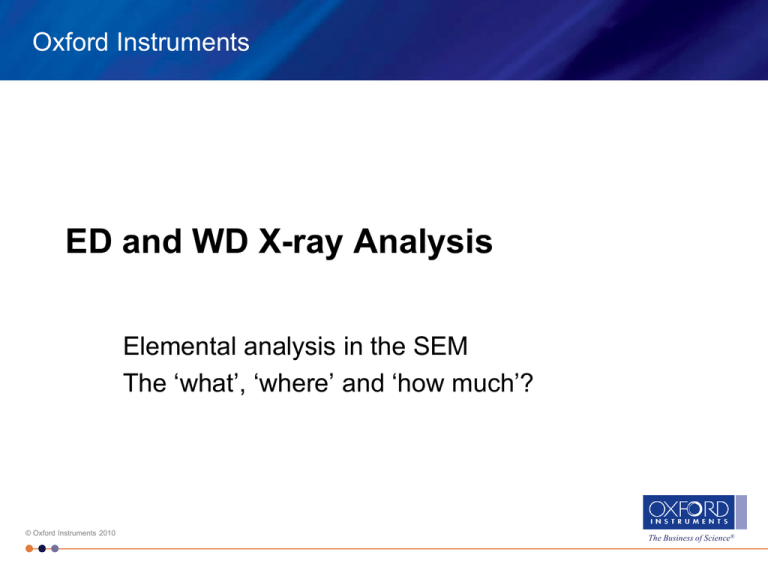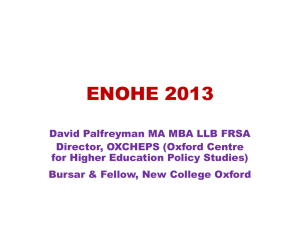ED and WD X-ray Analysis
advertisement

Oxford Instruments ED and WD X-ray Analysis Elemental analysis in the SEM The ‘what’, ‘where’ and ‘how much’? © Oxford Instruments 2010 The Business of Science® Oxford Instruments ‘What’ - Identifying the elements • Locate the electron beam on the region of the sample • Start acquisition • Spectrum shows peaks • Elements are identified and labelled • The higher the peak is above the background, the higher the concentration of that element Spectrum 1 Ta W Hf Ta Hf Ti © Oxford Instruments 2010 Ti Ni 0 1 2 3 Full Scale 20347 cts Cursor: -0.016 (2615 cts) Ti 4 5 Ni Cr 6 7 Hf 8 Ta W Hf Ta W 9 10 keV The Business of Science® Oxford Instruments X-ray Generation K lines © Oxford Instruments 2010 L lines The Business of Science® Oxford Instruments X-ray line series Ca Ca Sn Sn Sn Sn Ca 2.8 3 3.2 3.4 3.6 Full Scale 69667 cts Cursor: 2.611 (653 cts) 3.8 4 Ca K series © Oxford Instruments 2010 Sn 4.2 4.4 4.6 4.8 keV Sn Sn 2.8 3 3.2 3.4 3.6 Full Scale 32058 cts Cursor: 2.614 (1014 cts) 3.8 4 4.2 Sn 4.4 4.6 4.8 keV Sn L series The Business of Science® Oxford Instruments ED and/or WD? • Energy dispersive • Measures X-ray from its energy • Wavelength dispersive • Measures X-ray from its wavelength • Energy in keV = 12.398/ wavelength in Angstroms © Oxford Instruments 2010 The Business of Science® Oxford Instruments ED detectors • Old type Si(Li) detectors needed to be kept at liquid nitrogen temperature • New type SDD detectors are cooled to Peltier temperature • X-ray energy converted to charge pulse and then to a voltage pulse • Simultaneous acquisition of elements Be to U © Oxford Instruments 2010 The Business of Science® Oxford Instruments WD spectrometer • Diffraction according to Bragg’s law • nλ=2dsinθ • Much better peak resolution then ED • Much better sensitivity for trace elements • Sequential analysis of elements Be to U © Oxford Instruments 2010 The Business of Science® Oxford Instruments ED and WD together rare earth Ce resolution Ce Nd La Nd La Pr Ce Nd Ce La Nd La Ce Pr La Nd Ce La Pr Pr Pr 4.2 4.4 4.6 4.8 5 5.2 Full Scale ED 1552 cts Full Scale WD 18814 (100xcts/s) Cursor: 4.146 5.4 5.6 5.8 6 6.2 keV Spectrum 1 Fe Co +Co Mn Cr sensitivity Ni -Co +Mn -Mn Fe Cr © Oxford Instruments 2010 5.2 5.4 5.6 5.8 6 6.2 6.4 6.6 Full Scale ED 78582 cts Full Scale WD 30 (100xcts/s) Cursor: 5.085 6.8 7 7.2 7.4 7.6 7.8 8 8.2 keV The Business of Science® Oxford Instruments What can be analysed? • Just about anything you can put in the SEM! • Microanalysis – typical volume analysed about 1µm • Depends on accelerating voltage and density • Nanoanalysis – need to reduce electron beam penetration • Reduce accelerating voltage • For best results the sample should be flat and polished and conducting • But often you can achieve adequate results from ‘rough’ samples © Oxford Instruments 2010 The Business of Science® Oxford Instruments Typical applications • • • • Comparing ‘good’ and ‘bad’ samples Identifying compositions in fine grain structures Identifying sources of contamination Measuring variation in composition across an interface © Oxford Instruments 2010 The Business of Science® Oxford Instruments Industrial and research applications • • • • • • • • • Failure analysis - automotive, aerospace, semiconductors Materials research Quality Control Photovoltaics Light Emitting Diodes Thin film analysis Artefact conservation Steel inclusions Gun Shot Residue forensics © Oxford Instruments 2010 The Business of Science® Oxford Instruments ‘Where’ - Mapping • Scan the electron beam and acquire X-ray information at each pixel position • Display the results as a series of maps for each element or as a single colour image © Oxford Instruments 2010 The Business of Science® Oxford Instruments Individual maps © Oxford Instruments 2010 The Business of Science® Oxford Instruments ED spectrum at each point Fe Fe Cr Cr Mg 1 2 3 4 5 Full Scale 94 cts Cursor: 0.241 (4 cts) Cr Fe 6 7 8 keV O Cr Fe Cr Si Mg Al O Cr Cr Fe Cr Fe Al Mg Ca C © Oxford Instruments 2010 1 2 3 4 5 Full Scale 1421 cts Cursor: 0.221 (26 cts) 6 7 8 Ca 1 2 3 4 5 Full Scale 1042 cts Cursor: 0.211 (21 cts) Cr Cr 6 7 8 keV The Business of Science® 9 keV Oxford Instruments Interaction volume Ni 5kV 0.1 µm 1µm Si 5kV 0.4 µm © Oxford Instruments 2010 The Business of Science® Oxford Instruments Mapping large areas • Field width 0.53mm 3x3 maps stitched • WD geometry requirement – will defocus at low mag. © Oxford Instruments 2010 The Business of Science® Oxford Instruments ‘How much’ – Quantitative Analysis © Oxford Instruments 2010 Element Weight% Al K 1.42 Ti K 1.29 Cr K 17.46 Fe K 33.65 Ni K 42.29 Mo L 3.88 Totals 100.00 The Business of Science® Oxford Instruments Processing for quant Grid Spectrum(3,3) Fe Ni Cr Ni Fe Mo Mo Cr Ti Al Cr Ti Fe Ni Ti 1 2 3 Full Scale 4591 cts Cursor: 0.077 (161 cts) • • • • 4 5 6 7 8 9 keV Measure peak areas Compare with standards Apply inter-element corrections For accurate results, the sample should be flat, polished, homogeneous (on the micro-scale) and conducting © Oxford Instruments 2010 The Business of Science® Oxford Instruments Detection limits Spectrum 5 Fe Co +Co Mn Cr +Mn Ni -Co -Mn Fe Cr Ti 5 5.2 5.4 5.6 5.8 6 6.2 6.4 Full Scale ED 72759 cts Full Scale WD 32 (100xcts/s) Cursor: 4.908 Co 6.6 6.8 7 7.2 7.4 7.6 7.8 8 keV • Typically 0.1% to 0.5% for ED • Order of magnitude better for WD • Exact detection limit depends on operating conditions and composition © Oxford Instruments 2010 The Business of Science® Oxford Instruments ED or WD? • ED for major elements, fast analysis, rough samples Ideal for a ‘quick look’ • WD for minor and trace elements and overlaps Better sensitivity and resolution, but slow • ED and WD are complementary techniques for analysis © Oxford Instruments 2010 The Business of Science®






